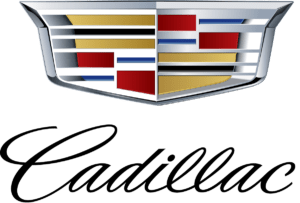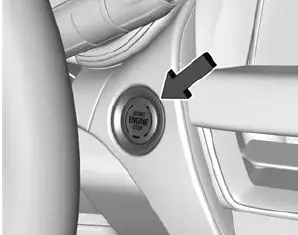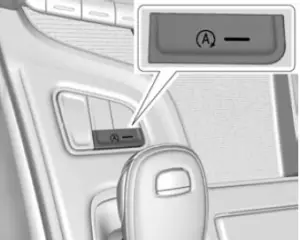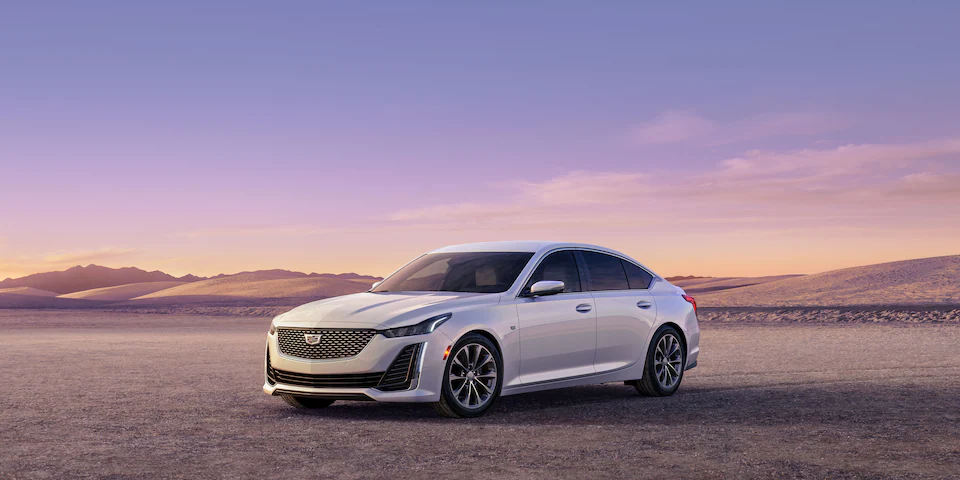 2023 Cadillac CT5 Engine Start & Stop | Tips for Driving
2023 Cadillac CT5 Engine Start & Stop | Tips for Driving
The 2023 Cadillac CT5, with its cutting-edge Engine Start & Stop technology, offers efficiency as well as performance, completely redefining the driving experience. We go over the main features of the CT5’s Engine Start & Stop function in this introduction, along with some driving advice, information on the engine heater system, and things to think about when parking for a long time. Let’s explore how Cadillac’s cutting-edge technology improves both the driving experience and owning a vehicle. Smooth and gentle braking is emphasized in the Cadillac CT5‘s driving advice to optimize the benefits of Engine Start & Stop. Allowing the system to anticipate pauses lets drivers maximize fuel efficiency and switch between engine states with ease. The manual offers advice on how to modify driving practices to take full advantage of this cutting-edge technology.
2023 Cadillac CT5 Specs, Price, Features, Mileage and Review
Starting and Operating
New Vehicle Break-In
Caution
Follow these recommended guidelines during the first 2 414 km (1,500 mi) of driving this vehicle. Parts have a break-in period and performance will be better in the long run.
- Avoid full-throttle starts and abrupt stops.
- Do not exceed 4000 engine rpm.
- Avoid driving at any one constant speed, fast or slow.
- Do not drive above 129 km/h (80 mph).
- Avoid downshifting to brake or slow the vehicle when the engine speed exceeds 4000 rpm.
- Do not let the engine labour. Never lug the engine in high gear at low speeds. With a manual transmission, shift to the next lower gear. This rule applies at all times, not just during the break-in period.
- Do not participate in racing events, sports driving schools, or similar activities during this break-in period.
- Check engine oil with every refuelling and add if necessary. Oil and fuel consumption may be higher than normal during the first 2 414 km (1,500 mi).
- To break in new tyres, drive at moderate speeds and avoid hard cornering for the first 322 km (200 mi).
- New tyres do not have maximum traction and may tend to slip.
- New brake linings also need a break-in period. Avoid making hard stops during the first 322 km (200 mi). This is recommended every time brake linings are replaced.
- Should the vehicle be used for racing or competitive driving (after the break-in), the rear axle lubricant must be replaced beforehand.
2023 Cadillac CT5 Engine Start & Stop Owners Manual
See Track Events and Competitive Driving (V-Series and V-Series Black wing) 0 191.
On new vehicles, the various mechanical and electrical systems experience a “break-in” period during the first 6,400 km (4,000 miles) of routine driving. As the vehicle is driven, the mechanical systems adjust to provide optimal fuel economy and transmission shift performance. Electrical systems will adapt and calibrate during the break-in period. A one-time occurrence of clicks and similar vehicle noises is normal during this process. Normal driving charges the vehicle’s battery to achieve the best operation of the vehicle, including fuel economy.
Composite Materials
This vehicle may be equipped with parts containing carbon fibre, sheet-moulding compound, or other composite materials. Dealer-installed accessories may also contain composite materials.
Warning
- Exposed edges of parts containing carbon fibre and other composite materials can be sharp. Contact with these parts could result in injury.
- Use caution to avoid contacting these parts, including when washing the vehicle. If the parts are damaged, replace the parts promptly with replacements from your dealer.
- Rocker extensions may break under pressure, resulting in property damage or injury. Do not stand on the rocker extension or use it as a step.
- Rear-end spoilers may break under pressure, resulting in property damage or injury. Do not push the vehicle by the spoiler or use the spoiler as a handle.
Ignition Positions
The vehicle has an electronic keyless ignition with a pushbutton start. The Remote Key must be in the vehicle for the system to operate. If the pushbutton start is not working, the vehicle may be near a strong radio antenna signal causing interference to the Keyless Access system. See Remote Key Operation 0 7. To shift out of P (Park), the vehicle must be on and the brake pedal must be applied.
Stopping the Engine/OFF (No Indicator
Lights) : When the vehicle is stopped, press ENGINE START/STOP once to turn the engine off. If the vehicle is in P (Park), the ignition will turn off, and Retained Accessory Power (RAP) will remain active. See Retained Accessory Power (RAP) 0 212. If the vehicle has an automatic transmission and is not in P (Park), the ignition will return to accessory mode and display a message in the Driver Information Center (DIC). When the vehicle is shifted into P (Park), the ignition system will turn OFF. If the vehicle has a manual transmission and is stationary, the ignition will turn off and Retained Accessory Power (RAP) will remain active. See Retained Accessory Power (RAP) 0 212. The vehicle may have an electric steering column lock. The lock is activated when the vehicle is switched to OFF and the driver’s door is opened. A sound may be heard as the lock actuates or releases. The steering column lock may not release with the wheels turned off centre. If this happens, the vehicle may not start. Move the steering wheel from left to right while attempting to start the vehicle. If this does not work, the vehicle needs service. Do not turn the engine off when the vehicle is moving. This will cause a loss of power assist in the brake and steering systems and disable the airbags.
If the vehicle must be shut off in an emergency:
- Brake using firm and steady pressure. Do not pump the brakes repeatedly. This may deplete power assist, requiring increased brake pedal force.
- Shift the vehicle to N (Neutral). This can be done while the vehicle is moving. After shifting to N (Neutral), firmly apply the brakes and steer the vehicle to a safe location.
- Come to a complete stop. Shift to P (Park) with an automatic transmission, or Neutral with a manual transmission. Turn the ignition off.
- Set the parking brake. See Electric Parking Brake 0 223.
Warning
Turning off the vehicle while moving may cause loss of power assist in the brake and steering systems and disable the airbags. While driving, only shut the vehicle off in an emergency. If the vehicle cannot be pulled over and must be shut off while driving, press and hold ENGINE START/STOP for longer than two seconds, or press twice within five seconds.
2023 Cadillac CT5 Engine Start & Stop User Manual
Accessory Mode
(Amber Indicator Light):
This mode allows the use of some electrical accessories when the engine is off. With the ignition off, pressing the button once without the brake pedal applied will place the ignition system in accessory mode. The ignition will switch from accessory mode to OFF after five minutes to prevent battery rundown.
ON/RUN/START
(Green Indicator Light) :
This mode is for driving and starting. With the ignition off, and the brake pedal applied, pressing the button once will place the ignition system in ON/RUN/START. Once engine cranking begins, release the button. Engine cranking will continue until the engine starts. See Starting the Engine 0 209. The ignition will then remain on.
Service Mode
This power mode is available for service and diagnostics, and to verify the proper operation of the malfunction indicator lamp as may be required for emission inspection purposes. With the vehicle off, and the brake pedal not applied, pressing and holding ENGINE START/STOP for more than five seconds will place the vehicle in Service Mode. The instruments and audio systems will operate as they do in ON/RUN, but the vehicle will not be able to be driven. The engine will not start in Service Mode. Press the button again to turn the vehicle off.
Starting the Engine
Place the transmission in the proper gear
Caution
If you add electrical parts or accessories, you could change the way the engine operates. Any resulting damage would not be covered by the vehicle warranty. See Add-On Electrical Equipment 0 288.
Automatic Transmission
Move the shift lever to P (Park) or N (Neutral). To restart the vehicle when it is already moving, use N (Neutral) only.
Caution
Do not try to shift to P (Park) if the vehicle is moving. If you do, you could damage the transmission. Shift to P (Park) only when the vehicle is stopped.
Manual Transmission
The shift lever should be in Neutral and the parking brake engaged. Hold the clutch pedal down to the floor, press the brake pedal, and start the engine.
Starting the Vehicle
- For vehicles with an automatic transmission, press the brake pedal, then press ENGINE START/STOP on the instrument panel. For a manual transmission, place the shift lever in Neutral with the parking brake engaged. Hold the clutch pedal down to the floor, press the brake pedal, then press ENGINE START/STOP.
If the remote key is not in the vehicle, if there is interference, or if the remote key battery is low, a Driver Information Center (DIC) message will display. See Remote Key Operation 0 7.
Caution
Cranking the engine for long periods, by pressing the ENGINE START/STOP immediately after cranking has ended, can overheat and damage the cranking motor, and drain the battery. Wait at least 15 seconds between each try, to let the cranking motor cool down - If the engine does not start after five to 10 seconds, especially in very cold weather (below −18 °C or 0 °F), it could be flooded with too much gasoline. Try pushing the accelerator pedal to the floor and hold it there, then press ENGINE START/STOP for up to a maximum of 15 seconds. Wait at least 15 seconds between each try, to allow the cranking motor to cool down. When the engine starts, let go of the button and the accelerator. If the vehicle starts briefly but then stops again, do the same thing. This clears the extra gasoline from the engine. Do not race the engine immediately after starting it. Operate the engine and transmission gently until the oil warms up and lubricates all moving parts.
2023 Cadillac CT5 Engine Start & Stop User Guide
Stopping the Engine
If the vehicle has an automatic transmission, move the shift lever to P (Park) and press and hold ENGINE START/STOP on the instrument panel, until the engine shuts off. If the shift lever is not in P (Park), the engine shuts off and the ignition goes to accessory mode. The DIC displays SHIFT TO PARK. Once the shift lever is moved to P (Park), the vehicle turns off.
If the vehicle has a manual transmission, before getting out of the vehicle, shift to 1 (First) or R (Reverse) and apply the parking brake. Then turn off the ignition off by pressing ENGINE START/STOP and release the clutch pedal when the engine has stopped. If the remote key is not detected inside the vehicle when it is turned off the DIC displays a message.
CT5 Start-Stop System
Stop/Start System
If equipped, the Stop/Start system will shut off the engine to help conserve fuel. It has off the engine to help conserve fuel. It has several starts.
Warning
The automatic engine Stop/Start feature causes the engine to shut off while the vehicle is still on. Do not exit the vehicle before shifting to P (Park). The vehicle may restart and move unexpectedly. Always shift to P (Park), and then turn the ignition off before exiting the vehicle.
Auto Engine Stop/Start
When the brakes are applied and the vehicles are at a complete stop, the engine may turn off. When stopped, the tachometer displays AUTO STOP. See Tachometer 0 95. When the brake pedal is released or the accelerator pedal is pressed, the engine will restart. To maintain vehicle performance, other To maintain vehicle performance, others automatically restart before the brake pedal is released.
Auto Stops may not occur and/or Auto
Starts may occur because
- The climate control settings require the engine to be running to cool or heat the vehicle interior.
- The vehicle battery needs to be charged.
- The vehicle battery has recently been disconnected.
- Minimum vehicle speed has not been reached since the last Auto Stop.
- The accelerator pedal is pressed.
- The engine or transmission is not at the required operating temperature.
- The outside temperature is not in the required operating range.
- The vehicle is shifted out of D (Drive) to any gear other than P (Park).
- Certain driver modes have been selected. See Driver Mode Control 0 227.
- The vehicle is on a steep hill or grade.
- The driver door has been opened or the driver seat belt has been unbuckled.
- The hood has been opened.
- The Auto Stop has reached the maximum allowed time
Auto Stop Disable Switch
The automatic engine Stop/Start feature can be disabled and enabled by pressing h. Auto Stop/Start is enabled each time you start the vehicle. When the indicator is illuminated, the system is enabled.
Engine Heater
Vehicles with the engine heater can use this option in cold weather conditions at or below −18 °C (0 °F) for easier starting and better fuel economy during engine warm-up. Plug in the engine heater at least four hours before starting your vehicle. An internal thermostat in the plug-end of the cord may exist which will prevent engine heater operation at temperatures above −18 °C (0 °F).
Cold Weather Engine Tips
To Use the Engine Heater
Turn off the engine. Check the heater cord for damage. If it is damaged, do not use it. See your dealer for a replacement. Inspect the cord for damage yearly. Warning
Warning
Improper use of the heater cord or an extension cord can damage the cord and may result in overheating and fire.
- Plug the cord into a three-prong electrical utility receptacle that is protected by a ground fault detection function. An ungrounded outlet could cause an electric shock.
- Use a weatherproof, heavy-duty, 15 amp-rated extension cord if needed. Failure to use the recommended extension cord in good operating condition, or using a damaged heater or extension cord, could make it overheat and cause a fire, property damage, electric shock, and injury.
Do not operate the vehicle with the heater cord permanently attached to the vehicle. Possible heater cord and thermostat damage could occur
While in use, do not let the heater cord touch vehicle parts or sharp edges. Never close the hood on the heater cord.
- Before starting the vehicle, unplug the cord, reattach the cover to the plug, and securely fasten the cord. Keep the cord away from any moving parts.
Before starting the engine, be sure to unplug and store the cord as it was before to keep it away from moving engine parts. If you do not, it could be damaged. Contact your dealer for information on how long to use the heater in your particular area.
Retained Accessory Power (RAP)
Retained Accessory Power (RAP) off the following features (if equipped) will continue to function for up to 10 minutes, or until the driver door is opened. These features will also work when the vehicle is on or in accessory mode:
- Infotainment System
- Power Windows (during RAP this functionality will be lost when any door is opened)
- Sunroof (during RAP this functionality will be lost when any door is opened)
- Auxiliary Power Outlet
- Audio System
- OnStar System
Shifting Into Park
To shift into P (Park)
- Hold the brake pedal down and set the parking brake. See Electric Parking Brake 0 223.
- Press the button on top of the shift lever to shift into P (Park). See Automatic Transmission 0 215.
- The P indicator on the shift lever will turn red when the vehicle is in P (Park). If the vehicle is shifted into P (Park) on a hill, the Electric Parking Brake (EPB) may apply automatically. You may not be able to release the EPB using the EPB switch. It should automatically release when the vehicle is shifted out of P (Park).
Leaving the Vehicle with the Engine Running
Warning
It can be dangerous to leave the vehicle with the engine running. It could overheat and catch fire. It is dangerous to get out of the vehicle if the vehicle is not in P (Park) with the parking brake set. The vehicle can roll. Do not leave the vehicle when the engine is running. If you have left the engine running, the vehicle can move suddenly. You or others could be injured. To be sure the vehicle will not move, even when you are on fairly level ground, always set the parking brake and shift to P (Park). See Shifting Into Park 0 212. If you are towing a trailer, see Driving Characteristics and Towing Tips 0 283.
If you are towing a trailer and parking on a hill, see Driving Characteristics and Towing Tips 0 283. This vehicle is equipped with an electronic transmission. The shift lock release button is designed to prevent inadvertent shifting out of P (Park).
To shift out of P (Park):
- Ensure the engine is running.
- Apply the brake pedal.
- Press and hold the shift lock release button on the shift lever.
- Move the shift lever to the desired position. For N (Neutral) hold the lever in the N (Neutral) position until the N indicator illuminates red.
- The P indicator will turn white and the gear indicator will turn red when the vehicle is no longer in P (Park).
- After releasing the shift lever, it will return to the centre position. If equipped, the Buckle to Drive feature may prevent shifting from P (Park). See Buckle To Drive 0 44.
If the vehicle cannot shift from P (Park), a Driver Information Center (DIC) message may be displayed. Check that the ignition is on, the engine is running, the brake pedal is applied, and the shift lock release button is pressed when you are attempting to shift out of P (Park). If all of these are met but the vehicle will not shift out of P (Park), see your dealer for service.
Parking (Manual Transmission)
Warning
If the vehicle has a manual transmission, never get out of the vehicle without first moving the shift lever into 1st or R (Reverse), setting the parking brake, and turning the ignition off. The vehicle can roll, which could cause serious injury or death.
Parking over Things That Burn
Warning
Things that can burn could touch hot exhaust parts under the vehicle and ignite. Do not park over papers, leaves, dry grass, or other things that can burn.
Active Fuel Management
This vehicle’s engine may be equipped with Active Fuel Management, which allows the engine to operate on either all of it cylinders or in reduced-cylinder operation mode, depending on the driving conditions. When less power is required, such as cruising at a constant vehicle speed, the system will operate in reduced cylinder operation mode, allowing the vehicle to achieve better fuel economy. When greater power demands are required, such as accelerating from a stop, passing, or merging onto a freeway, the system will maintain full-cylinder operation. If the vehicle has an Active Fuel Management indicator, see the Driver Information Center (DIC) for more information on using this display.
Extended Parking
It is best not to park with the vehicle running. If the vehicle is left running, be sure it will not move and there is adequate ventilation. See Shifting Into Park 0 212 and Engine Exhaust 0 214. If the vehicle is left parked and running with the remote key outside the vehicle, it will continue to run for up to 15 minutes. If the vehicle is left parked and running with the remote key inside the vehicle, it will continue to run for up to 30 minutes.
Extended Parking Recommendations
Automatic Transmission
The timer will reset if the vehicle is taken out of P (Park) while it is running.
Manual Transmission
The timer will reset if the vehicle speed exceeds 4 km/h (2.5 mph). The vehicle could turn off sooner if it is parked on a hill, due to a lack of available fuel.
FAQS
The Engine Start & Stop feature is designed to enhance fuel efficiency and reduce emissions by automatically shutting off the engine when the vehicle comes to a stop and restarting it when needed.
The system automatically stops the engine when the vehicle is stationary, such as at traffic lights, and restarts it seamlessly when the driver releases the brake pedal, ensuring a smooth driving experience.
Depending on the vehicle’s design, there may be an option for the driver to manually disable the Engine Start & Stop feature.
Smooth and gradual braking allows the system to predict stops in advance, optimizing fuel efficiency. The guide may provide insights into adapting driving habits to make the most of this feature.
The engine typically restarts quickly, providing a seamless transition when the brake pedal is released. The system is designed for efficiency and minimal delay.
In most cases, the Engine Start & Stop system is designed to maintain essential vehicle functions, such as air conditioning and infotainment, even when the engine is temporarily off.
The Engine Heater system warms up the engine before driving in low temperatures, promoting optimal performance and reducing wear and tear, especially in colder climates.
The Engine Heater system may be automatic, activating as needed based on external temperature conditions.
The warming-up duration may vary, but the Engine Heater system is designed to efficiently warm up the engine before driving in cold temperatures.
During extended parking, the system may temporarily deactivate to preserve battery life. The guide provides considerations for drivers to be aware of when leaving the vehicle parked for an extended duration.
Extended parking typically doesn’t impact the long-term performance of the Engine Start & Stop system. The system is designed to adapt to various driving conditions.
The guide may provide tips for a seamless return to driving after extended parking, ensuring the Engine Start & Stop system functions optimally.
The fuel savings from the Engine Start & Stop system can vary based on driving conditions and usage. It is designed to contribute to overall fuel efficiency.
Depending on the vehicle’s design, there may be options to disable the Engine Start & Stop feature permanently. Refer to the owner’s manual for instructions on customization.
The engine Start & Stop system typically doesn’t require additional maintenance. Regular vehicle maintenance is recommended to ensure optimal system performance.
Useful Links
View Full User Guide: Cadillac CT5 2023 User Guide
Download Manuals: https://www.cadillac.com/support/vehicle/manuals-guides
2023 Cadillac CT5 Voice Recognition And Phone User Guide
2023 Cadillac CT5 Specs, Price, Features, Mileage and Review

